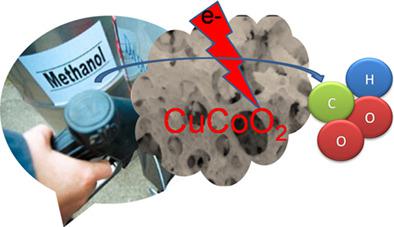当前位置:
X-MOL 学术
›
Int. J. Energy Res.
›
论文详情
Our official English website, www.x-mol.net, welcomes your feedback! (Note: you will need to create a separate account there.)
Honeycomb like copper‐cobalt nanostructures and their synergy with carbon supports for electrooxidation of carbinol
International Journal of Energy Research ( IF 4.6 ) Pub Date : 2020-11-24 , DOI: 10.1002/er.6231 Divya C. Sesu 1, 2 , Anita Swami 1, 3 , Bhalchandra Kakade 1, 3
International Journal of Energy Research ( IF 4.6 ) Pub Date : 2020-11-24 , DOI: 10.1002/er.6231 Divya C. Sesu 1, 2 , Anita Swami 1, 3 , Bhalchandra Kakade 1, 3
Affiliation

|
Fabricating the significant electrocatalysts with enriched activity and stability is necessary due to the increasing demands of the fuel cell industries for its commercialization. This report provides a widespread impact on fabrication of a suitable and significant porous bimetallic nanocatalyst for methanol oxidation reaction (MOR). Here, we have developed nanofoams of Cu‐Co alloys/oxides with varied carbon supports using simple combustion method, where graphite oxide (GO) shows synergistic “catalyst‐support” effect than other substrates. The morphological studies reveal a honeycomb‐like structure with dense porous nature of Cu‐Co nanofoam (CuCo@rGO). X‐ray diffraction and spectroscopic studies reveal the formation of spinel structure of CuCo2O4 with active {110} facets in case of CuCo@rGO, exhibiting higher methanol electrooxidation activity of 198 mA/cm2, which is found to be improved than that of the previous reports. The optimized composition, CuCo@rGO shows the slow decrease in the current in chronoamperometric studies with 40% retention of its activity even after 10 hours. The CoCu@rGO nanofoam shows improved Brunauer‐Emmett‐Teller surface area of ~50 m2/g due to the addition of GO. In addition, the composite shows an excellent electrochemical surface area value of 7.75 m2/g over other compositions of different carbon supports. The intrinsic effect of better conductivity of Co75Cu25@rGO has also been confirmed using impedance spectroscopy. The porous honeycomb structure of Co75Cu25@rGO composite synergistically impacts methanol oxidation and also forbids the formation of CO intermediate, maintaining the activity.
中文翻译:

蜂窝状的铜钴纳米结构及其与碳载体的协同作用,以实现甲醇的电氧化
由于燃料电池工业对其商业化的需求不断增加,因此必须制造具有丰富活性和稳定性的重要电催化剂。该报告对用于甲醇氧化反应(MOR)的合适且重要的多孔双金属纳米催化剂的制备产生了广泛的影响。在这里,我们使用简单的燃烧方法开发了具有多种碳载体的Cu-Co合金/氧化物纳米泡沫,其中氧化石墨(GO)比其他基质具有协同的“催化剂-载体”效果。形态学研究表明,蜂窝状结构具有密集的Cu-Co纳米泡沫(CuCo @ rGO)多孔性。X射线衍射和光谱研究揭示了CuCo 2 O 4的尖晶石结构的形成在CuCo @ rGO的情况下具有活跃的{110}刻面,表现出更高的甲醇电氧化活性198 mA / cm 2,这被发现比以前的报告有所改善。经过优化的成分CuCo @ rGO在计时安培法研究中显示了电流的缓慢降低,即使在10小时后仍保持40%的活性。由于添加了GO ,CoCu @ rGO纳米泡沫的Brunauer-Emmett-Teller表面积提高了约50 m 2 / g。此外,该复合材料的电化学表面积极佳,为7.75 m 2/ g,高于不同碳载体的其他组合物。Co75Cu25 @ rGO的更好电导率的内在作用也已通过阻抗谱得到了证实。Co75Cu25 @ rGO复合材料的多孔蜂窝结构协同影响甲醇的氧化,并禁止形成CO中间体,从而保持活性。
更新日期:2020-11-24
中文翻译:

蜂窝状的铜钴纳米结构及其与碳载体的协同作用,以实现甲醇的电氧化
由于燃料电池工业对其商业化的需求不断增加,因此必须制造具有丰富活性和稳定性的重要电催化剂。该报告对用于甲醇氧化反应(MOR)的合适且重要的多孔双金属纳米催化剂的制备产生了广泛的影响。在这里,我们使用简单的燃烧方法开发了具有多种碳载体的Cu-Co合金/氧化物纳米泡沫,其中氧化石墨(GO)比其他基质具有协同的“催化剂-载体”效果。形态学研究表明,蜂窝状结构具有密集的Cu-Co纳米泡沫(CuCo @ rGO)多孔性。X射线衍射和光谱研究揭示了CuCo 2 O 4的尖晶石结构的形成在CuCo @ rGO的情况下具有活跃的{110}刻面,表现出更高的甲醇电氧化活性198 mA / cm 2,这被发现比以前的报告有所改善。经过优化的成分CuCo @ rGO在计时安培法研究中显示了电流的缓慢降低,即使在10小时后仍保持40%的活性。由于添加了GO ,CoCu @ rGO纳米泡沫的Brunauer-Emmett-Teller表面积提高了约50 m 2 / g。此外,该复合材料的电化学表面积极佳,为7.75 m 2/ g,高于不同碳载体的其他组合物。Co75Cu25 @ rGO的更好电导率的内在作用也已通过阻抗谱得到了证实。Co75Cu25 @ rGO复合材料的多孔蜂窝结构协同影响甲醇的氧化,并禁止形成CO中间体,从而保持活性。


























 京公网安备 11010802027423号
京公网安备 11010802027423号